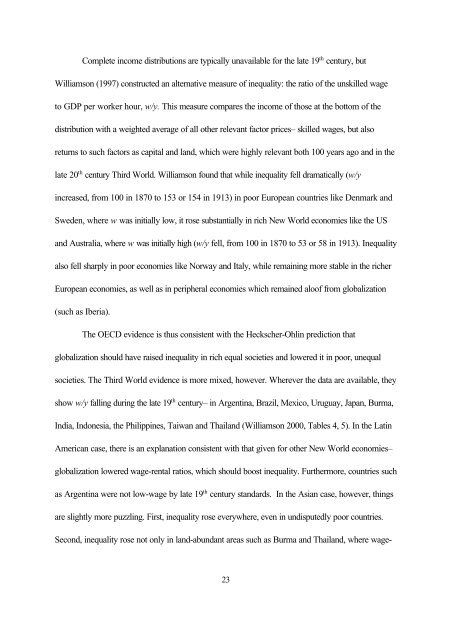Globalization and Inequality - Trinity College Dublin
Globalization and Inequality - Trinity College Dublin
Globalization and Inequality - Trinity College Dublin
You also want an ePaper? Increase the reach of your titles
YUMPU automatically turns print PDFs into web optimized ePapers that Google loves.
Complete income distributions are typically unavailable for the late 19 th century, but<br />
Williamson (1997) constructed an alternative measure of inequality: the ratio of the unskilled wage<br />
to GDP per worker hour, w/y. This measure compares the income of those at the bottom of the<br />
distribution with a weighted average of all other relevant factor prices– skilled wages, but also<br />
returns to such factors as capital <strong>and</strong> l<strong>and</strong>, which were highly relevant both 100 years ago <strong>and</strong> in the<br />
late 20 th century Third World. Williamson found that while inequality fell dramatically (w/y<br />
increased, from 100 in 1870 to 153 or 154 in 1913) in poor European countries like Denmark <strong>and</strong><br />
Sweden, where w was initially low, it rose substantially in rich New World economies like the US<br />
<strong>and</strong> Australia, where w was initially high (w/y fell, from 100 in 1870 to 53 or 58 in 1913). <strong>Inequality</strong><br />
also fell sharply in poor economies like Norway <strong>and</strong> Italy, while remaining more stable in the richer<br />
European economies, as well as in peripheral economies which remained aloof from globalization<br />
(such as Iberia).<br />
The OECD evidence is thus consistent with the Heckscher-Ohlin prediction that<br />
globalization should have raised inequality in rich equal societies <strong>and</strong> lowered it in poor, unequal<br />
societies. The Third World evidence is more mixed, however. Wherever the data are available, they<br />
show w/y falling during the late 19 th century– in Argentina, Brazil, Mexico, Uruguay, Japan, Burma,<br />
India, Indonesia, the Philippines, Taiwan <strong>and</strong> Thail<strong>and</strong> (Williamson 2000, Tables 4, 5). In the Latin<br />
American case, there is an explanation consistent with that given for other New World economies–<br />
globalization lowered wage-rental ratios, which should boost inequality. Furthermore, countries such<br />
as Argentina were not low-wage by late 19 th century st<strong>and</strong>ards. In the Asian case, however, things<br />
are slightly more puzzling. First, inequality rose everywhere, even in undisputedly poor countries.<br />
Second, inequality rose not only in l<strong>and</strong>-abundant areas such as Burma <strong>and</strong> Thail<strong>and</strong>, where wage-<br />
23
















